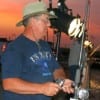 By Ed Snyder/Outdoors
By Ed Snyder/Outdoors
The quietness of the Coleman Lantern is all but gone now, replaced by a more noisy, smelly, and luminous age of high technology. Just pay a visit to Rollover Pass on any given summery night and you’ll be greeted by a small city of lights with its residents standing elbow to elbow casting into pools of light in hopes of catching “whatever” is biting. Which, in most cases will involve speckled trout, the main attraction for the anglers being there in the first place.
“Back in the day”, we used Coleman lanterns with reflectors attached hanging from poles for our night-fishing trips. But this was before portable generators made it much more convenient for anglers to fish in the cool of the night. And I must agree, in some cases, the new night-fishing systems are much more productive. BUT, then again, “back in the day” the trout limits were 20 specks per angler, which now only allows 10 specks with an added limit of only one over 25 inches in that 10 trout creel.
Portable Generators of today’s market are getting smaller, quieter, and cheaper now with light systems that have deep penetration capabilities when aimed into the depths of the water. This is imperative when seeking to attract the often Wylie and spooky predator fish such as speckled trout.
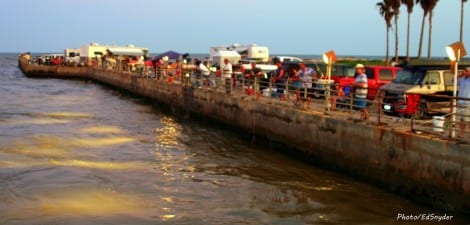
Popular night-fishing draws plenty of action
The whole reason for this type of fishing is to attract the bait, such as shrimp, shad, finger mullet, or ghost minnows to the light which in turn attract speckled trout. Usually within 30 minutes of running your lights, the bait will begin to show, and usually within minutes after the bait-fish show the specks will arrive to feed on the bait.
The main thing you need to know is the schooly trout (smaller specks from 12 to 18 inches) will crowd the light circles in hopes of feasting on the abundance of bait attracted by the light. But lurking in the shadows outside the circle of light are the lunker trout. What they do is wait for the “kiddos” to maul the bait which will float into the shadows where they can feed with the least amount energy. BIG TROUT are lazy and will often take advantage of the situation.
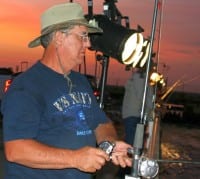
Night-Shift angler casting the lights
Another least known light rig is the inverter/battery light system. This rig is limited for its brightness but it does work. A 12 volt car battery hooked up to an electric inverter that converts the 12 volts to 120 volts is then hooked up with two 75 watt light bulbs. Set these lights low over the water for maximum effort AWAY from other stronger lights, and it should get the job done. One plus factor for this system is “QUIET” with no noisy generator to put up with.
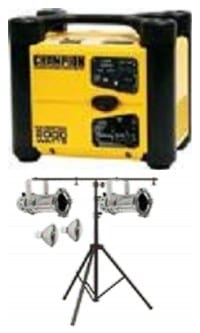
Portable Generators are much smaller and quieter now, shown with a typical light tripod
Fishing gear can be of any type, BUT, casting gear such as medium/light casting rods rigged with level-wind bait-casting reels -or- open face spinning rods and reels spooled with 12 lb test mono or braided line are highly recommended. The baits can be live shrimp or finger mullet rigged free-lined style -or- artificial lures such as soft plastics (Gulp or Assassins) or hard plastics (MirrOlures or Rat-L-Traps) .
There is a fishing etiquette to follow for night-fishing enthusiasts which is to be adhered to IF you want to maintain your fishing spot on the line. When casting with multiple anglers in a elbow to elbow situation, ideal casting would be to synchronize your cast in a rhythm up-current of the tide allowing your bait to drift thru the light cone into the down-current shadow, retrieve, then recasting when your turn comes. The absolute worse scenario is when your cast falls out of rhythm causing tangled lines and frustrated anglers. You’ll catch on just by watching the seasoned night-shift anglers casting rhythms.
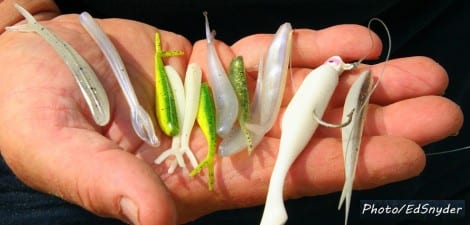
A handfull of the most popular lures used at night
ALSO!! ALWAYS ask permission when fishing other anglers light cones. Nothing is more irritating to night-shift anglers then when other anglers move in on them to fish their lights. Often arguments or even fights have occurred when welcomed or unruly anglers move in on a fishing group.
In order to keep your fish fresh and ready for the table, immediately stow them in a cooler of ice. This will guarantee freshness. If you tether them on a stringer, the fish will stress out, pumping an ammonia-like gas through their system making them taste gamey when cooked. Icing them down will chill them out and keep the flesh fresh and tasty.
Speckled sea-trout are very tasty when kept on ice and cleaned properly, and if you decide to store filets for future fish fries, just add a teaspoon of Real Lemon juice in each freezer bag of filets. This will keep them tasting fresh for at least six months. Whether you like them fried, sauteed, or grilled, the speckled sea-trout will produce many smiles around your table.
Texas Fish & Game regulations as of June 2014 list the Speckled Sea Trout limits as 15 inches minimum for a ten speck daily bag limit with only one speck over 25 inches allowed. Which is a bountiful catch for any angler. This is not to say that after you catch your limit you have to stop; you can continue catch and release only. What you cannot do is cull your catch, which is releasing a smaller trout for a larger one. Speckled trout kept in a cooler are already dead and those on a stringer will not survive. So be sure you abide by the ruling to protect our fishing resource.
This Article sponsored by The Beach Triton, FishingWorld.com, Miss Nancy’s Bait Camp (Face Book), CrystalBeachLocalNews.com, The Home Town Press
(Published 8/10/2015)
.

 Posted in
Posted in 























